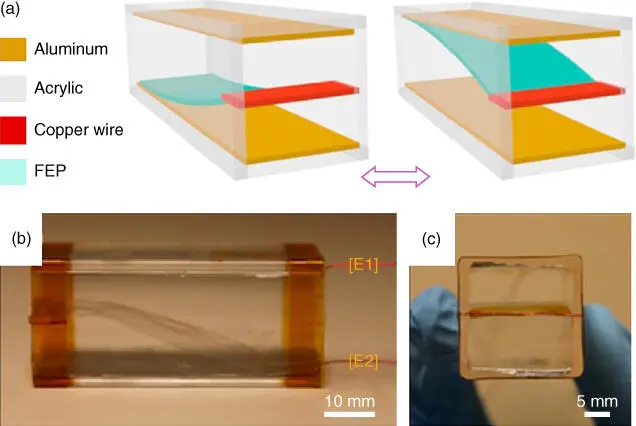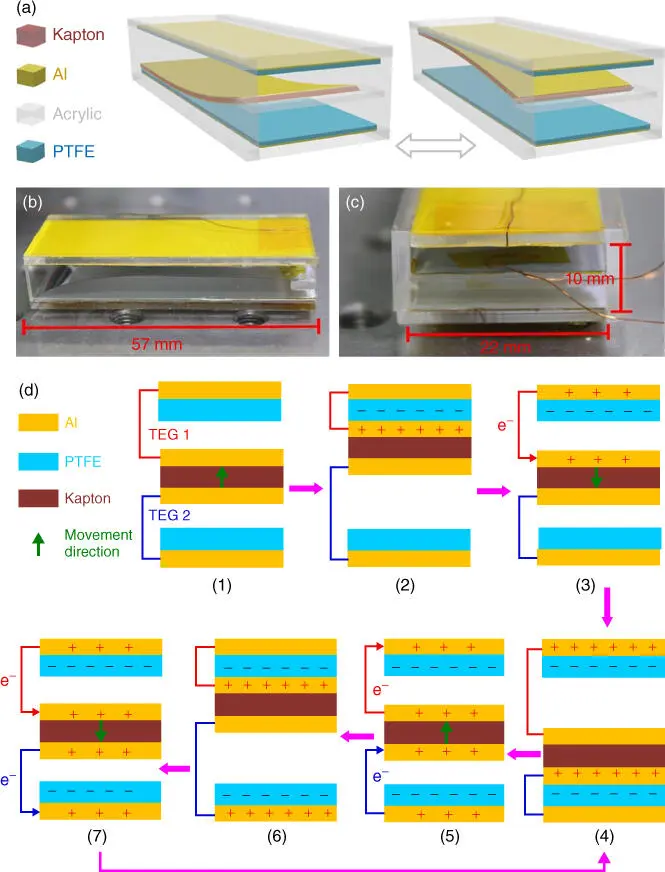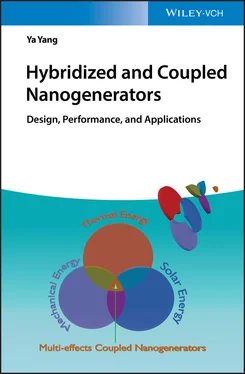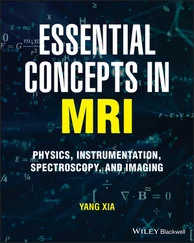Ya Yang - Hybridized and Coupled Nanogenerators
Здесь есть возможность читать онлайн «Ya Yang - Hybridized and Coupled Nanogenerators» — ознакомительный отрывок электронной книги совершенно бесплатно, а после прочтения отрывка купить полную версию. В некоторых случаях можно слушать аудио, скачать через торрент в формате fb2 и присутствует краткое содержание. Жанр: unrecognised, на английском языке. Описание произведения, (предисловие) а так же отзывы посетителей доступны на портале библиотеки ЛибКат.
- Название:Hybridized and Coupled Nanogenerators
- Автор:
- Жанр:
- Год:неизвестен
- ISBN:нет данных
- Рейтинг книги:3 / 5. Голосов: 1
-
Избранное:Добавить в избранное
- Отзывы:
-
Ваша оценка:
- 60
- 1
- 2
- 3
- 4
- 5
Hybridized and Coupled Nanogenerators: краткое содержание, описание и аннотация
Предлагаем к чтению аннотацию, описание, краткое содержание или предисловие (зависит от того, что написал сам автор книги «Hybridized and Coupled Nanogenerators»). Если вы не нашли необходимую информацию о книге — напишите в комментариях, мы постараемся отыскать её.
Hybridized and Coupled Nanogenerators — читать онлайн ознакомительный отрывок
Ниже представлен текст книги, разбитый по страницам. Система сохранения места последней прочитанной страницы, позволяет с удобством читать онлайн бесплатно книгу «Hybridized and Coupled Nanogenerators», без необходимости каждый раз заново искать на чём Вы остановились. Поставьте закладку, и сможете в любой момент перейти на страницу, на которой закончили чтение.
Интервал:
Закладка:
2.2.2 Applications
In some ground locations or elevated locations, standalone wind turbines have been used to harvest wind energy. To realize broader applications, some researchers expect to design small‐scale standalone wind power sources, and they must conquer some key questions, such as challenges of low capacity factor, high costs, and finite capacity to store electricity. HAWTs and VAWTs have been widely used in the urban environment to transform wind energy to electricity generation because their sources are close to the electrical load. Recently, there are some systems that have been integrated into the ambient environment. For example, micro‐wind turbines, which can be mounted on existing homes, form one of the techniques for application in urban environment ( Figure 2.1c) [30]. On urban expressways, novel turbines are used to capture the energy generated by driving cars at high speeds ( Figure 2.1d) [30,31].
2.3 Triboelectric Nanogenerators for Scavenging Wind Energy
In January 2012, the TENG was first introduced to harvest mechanical energy. Owing to its low cost and high efficiency, TENG provides a novel way for scavenging wind energy in our daily living environment. There are many types of TENGs to harvest wind energy. Among them, vibrating plate‐based TENGs have been widely used because of the high output performance.
2.3.1 Fundamental Modes and Structure
Currently, TENGs mainly depend on four modes, including vertical contact‐separation mode, in‐plane sliding mode, single‐electrode mode, and freestanding triboelectric‐layer mode. In consideration of the application, vertical contact‐separation mode was more suitable for harvesting wind energy.
2.3.1.1 Vibrating Plate‐Based TENGs
Yang et al. proposed vibrating plate‐based TENGs to harvest wind energy in our daily living environment, which consists of two aluminum (Al) foils and a fluorinated ethylene‐propylene (FEP) film in a rectangular acrylic tube, as shown in Figure 2.2a [32]. The Al foils were stuck on the upper and lower ends, which can be used as both electrodes and triboelectric surfaces. To vibrate along with the wind, one side of the FEP film was clamped to the rectangular acrylic tube. The periodic contact between the FEP film and the Al foils can generate an output current across an external circuit. The side view of the fabricated plate‐based TENG shows that the device is light and handy ( Figure 2.2b). Figure 2.2c shows the front view of the device.

Figure 2.2Diagram of the plate‐based TENG. (a) Schematic diagram of the TENG. (b,c) The side and front views of the TENG.
Source: Reproduced with permission from Yang et al. [32]. Copyright 2013, American Chemical Society.
The working mechanism of the plate‐based TENG is schematically represented in Figure 2.3. At the initial state, contact between the surface of the Al foil and the FEP film led to electrons transfer from Al to FEP, resulting in positive charges on the surface of the Al foil and negative charges on the surface of the FEP. There is no current in the external circuit because the positive and negative triboelectric charges balance each other ( Figure 2.3a). When the FEP film segregates the bottom Al foil due to wind‐induced vibration the balance is destroyed, leading to the opposite current at the two Al foils ( Figure 2.3b). The electrostatic‐induced current will be maintained consistently until the negative triboelectric charges on the FEP film are completely screened from the positive charges, where the current signals disappear at the foils, as shown in Figure 2.3c. Subsequently, the FEP film was close to the bottom Al foil, leading the influent and the effluent current signals to the top and the bottom Al foils, respectively, as depicted in Figure 2.3d. This process finishes once the FEP film makes contact with the bottom Al foil due to the balance formed between them, as shown in Figure 2.3e. Figure 2.3f illustrates that the FEP film is close to the top Al foil, leading to the opposite current signals compared with those in Figure 2.3d. Consequently, plate‐based TENG, which can be driven between the two Al electrodes under vibration situation, can be used to harvest wind energy.
2.3.1.2 Enhanced Plate‐Based TEGs
The device structures and materials can affect the output performance of triboelectric generators (TEGs). To increase the actual efficiency for harvesting wind energy, some improved structures have been invented by optimizing the structures of the devices. For example, Yang's group proposed enhanced plate‐based TEG, which consists of two polytetrafluoroethylene (PTFE) films, two Al foils, and a Kapton film coated with Al electrodes on its surfaces ( Figure 2.4a) [33]. To bring wind‐induced vibration, one side of the Kapton film was fixed. The side view of the fabricated plate‐based TEG shows that the device is small, with the dimensions of 22 mm × 10 mm × 57 mm ( Figure 2.4b). Figure 2.4c shows the front view of the device, with a thickness of about 2 mm.

Figure 2.3Sketches illustrating the electricity generation process (a–f) in plate‐based TENG.
Source: Reproduced with permission from Yang et al. [32]. Copyright 2013, American Chemical Society.

Figure 2.4Diagram of the enhanced plate‐based TEG. (a) Schematic diagram of the TENG. (b,c) The side and front views of the TEG. (d) Sketches illustrating the electricity generation process in enhanced plate‐based TENG.
Source: Reproduced with permission from Wang et al. [33]. Copyright 2015, John Wiley and Sons.
The working mechanism of the enhanced plate‐based TEG is schematically depicted in Figure 2.4d. At the initial state, both TEG‐1 and TEG‐2 are in the static condition, resulting in no output signals ( Figure 2.4d(1)). When the Al electrode contacts with the top PTFE film in the TEG‐1, electrons will be transferred due to different triboelectric series, and their surfaces will respectively form positive charges and negative charges. This process will generate a balance due to the nature of the insulator, leading to no output signals ( Figure 2.4d(2)). When the distance between the Al electrode and the Kapton film was increased under the external force, the balance was broken, which could generate the current signal through an external load in the TEG‐1, as shown in Figure 2.4d(3). The electrostatic induced charges disappeared when a new balance is built, as descripted in Figure 2.4d(4). In this state, the surface of the Al electrode forms positive triboelectric charges, and the surface of the bottom PTFE film forms negative charges in TEG‐2. Increasing the distance between the Al electrode and the bottom PTFE can induce two output signals in TEG‐1 and TEG‐2 due to electrostatic induction.
2.3.1.3 Elasto‐aerodynamics‐Driven TENGs
Under high wind speed, enhancing the stability of the devices is very important because of complex factors, such as buffeting, vortex shedding, galloping, and flutter. There are some natural mechanical problems in the vibrating plate‐based TENGs due to a combination of bending and torsion. To increase the stability and output performances of TENGs, elasto‐aerodynamics‐driven TENG was developed, which consists of a Kapton film, two PTFE films, and Cu electrodes ( Figure 2.5a) [34]. Figure 2.5b shows the front view of the device.
Читать дальшеИнтервал:
Закладка:
Похожие книги на «Hybridized and Coupled Nanogenerators»
Представляем Вашему вниманию похожие книги на «Hybridized and Coupled Nanogenerators» списком для выбора. Мы отобрали схожую по названию и смыслу литературу в надежде предоставить читателям больше вариантов отыскать новые, интересные, ещё непрочитанные произведения.
Обсуждение, отзывы о книге «Hybridized and Coupled Nanogenerators» и просто собственные мнения читателей. Оставьте ваши комментарии, напишите, что Вы думаете о произведении, его смысле или главных героях. Укажите что конкретно понравилось, а что нет, и почему Вы так считаете.












